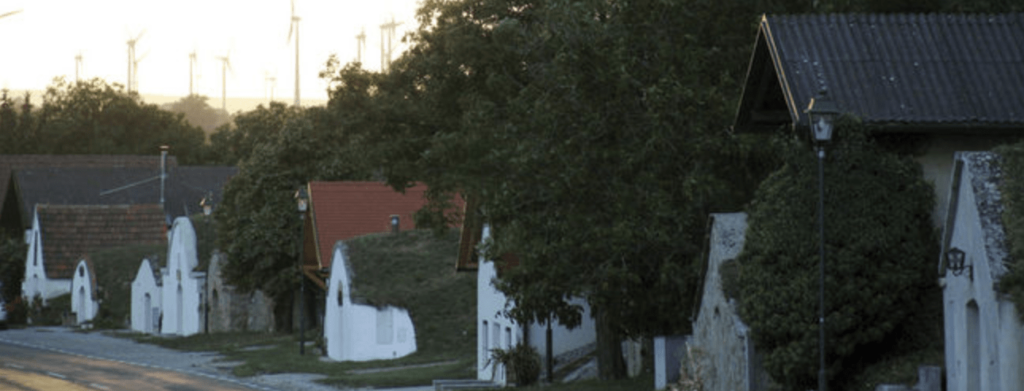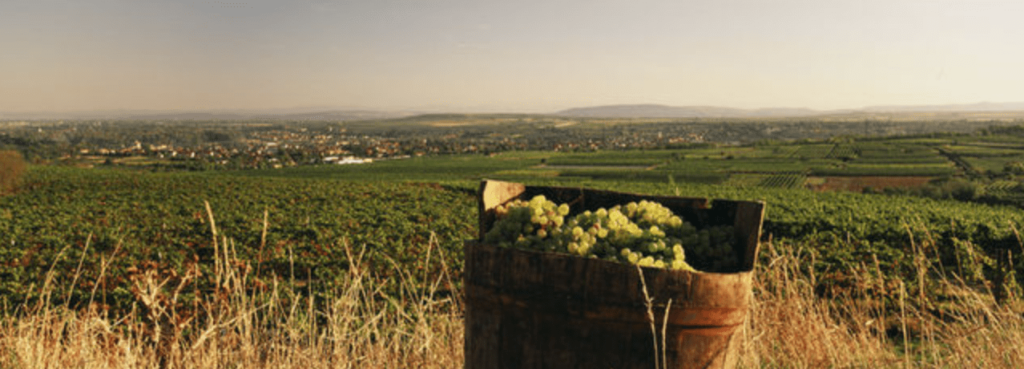There’s a black bunch next to a white bunch, which is next to a pink bunch. “This is the problem in Austria!” says winemaker Dorli Muhr, as we stand between vine rows and windmills in Spitzerberg. “The vineyards have passed down so many family lines that everyone just owns one row. And so every row is different and can be very mixed.” The minute scale of vineyard ownership in Austria’s wine regions is indeed a problem. One row of vines is hardly enough to make a few bottles, let alone a barrel, and it is hard to buy vineyard land here.
But Muhr has a different plan. She has been piecing together rows of old vines from different old men as they retire. “You can’t ask for their vineyards before they retire because it’s their hobby,” she explains in a tender tone as we walk through the vineyards, “each morning they come out to tend their vines and it’s what keeps them going. When they can’t do it anymore, they pass the vines on to their children, who just rip them out. But Austrian men are quite proud of their vines, so I had an idea…”
Muhr put up a polite notice at the local doctor’s surgery asking any of the older generation to pass on their old vines to her, so she could tend them and continue their legacy. She has garnered a couple of hectares this way, which all go towards her renowned single site wines made from vines aged between 50 and 75 years old.
This is, unfortunately, one of the few stories of rescued heritage. Many of Austria’s old vines are being uprooted as times change and new generations don’t care to potter about in grandad’s old vineyard – the diminutive sizes making it nigh on impossible to earn an income from winemaking.
When you drive around Austria’s wine regions you can see how strips of vines have transitioned into strips of soya, strips of corn, or garden allotments. Some strips are just left bare, the owners not ready to part with the land but also not prepared to cultivate it. In the fourteenth century, Austria had over 200,000 hectares of vines – today there are less than 50,000 hectares.

Close quarters with your neighbour: Typical wine houses in Carnuntum
Although the shrink in production doesn’t look great on paper, in reality, this was necessary for Austria to fine-tune its production following the anti-freeze scandal in the 80s and bulk wine production which led to a poor reputation for Austrian wine. During the 90s Austrian wine producers fought back with a revolution in producing high-quality wines, and the new generation realised that not all of Austria’s old vines were worth saving. “We had a lot of the wrong varieties planted in the wrong places…” admits another new generation grower, Gerhard Markowitsch. “It was a disaster.” However, some of these old vineyards and sites were worth saving, no matter how small, and this is how Austria has become a hotbed for exciting, single site wines.
“For historical reasons, the vineyards in Austria are quite fragmented,” explains winemaker and President of the Traditional Austrian Winemakers Association, Michael Moosbrugger, “Every winemaker in Austria has a small plot here, and a small plot there… The result is that winemakers are often working in 10 to 30 different single vineyards.”

It is based on these very distinct single vineyard wines that Austria is in the process of creating its classification system of vineyards. Although Austria has a wine history spanning over 2,000 years, it’s only since 2002 that Austria has started working on its modern appellation system and it has decided to base it on single vineyard wines.
A long-term investigation into the sites producing the best, and consistently excellent, wines is underway and winemakers in the Danube are adopting a 3-tier system for “Klassifizierte Lage” (the equivalent to Appellation Controlée), “Erste Lage” (like Premier Cru) and “Große Erste Lage” (which resembles Grand Cru). The Erste Lagen vineyards (61 in total, 16% of the production area) have already been defined, but the selection of the Große Erste Lagen vineyards is still fermenting in the minds of producers, press, experts and consumers and the results will only be announced several years down the line. What is for sure is that there are notable differences between wines and vineyard sites that make this process worthwhile.
While I was visiting Austria’s wine regions, I was fortunate enough to be invited for the Erste Lagen tasting, where I tasted 73 Grüner Veltliners and 59 Rieslings, all from the 2015 vintage, from 62 different Erste Lage vineyards (in Kamptel, Kremstal, Traisental and Wagram). Tasting 73 Grüner Veltliner wines from the same vintage might sound slightly taxing, but it was a wonderful opportunity to see how diverse the expression can be. While there were some clear differences in winemaking (bright, slightly effervescent vs. oak cask-matured for example), the main differences in the wines are to do with the site (or terroir, if you prefer).
Within the Erste Lagen vineyards you have a range of altitudes (between 210m to 380m) and different mesoclimates affected by each site’s proximity to the main rivers. These factors certainly affect the maturation rate, temperatures and final character of the wine. There’s also a wide range of soils that have been unearthed, deposited and eroded over time. Without going into the minutiae of Austrian geology or soils, you can most easily split the vineyard sites into two camps – primary rock (like limestone or schist) and loess (windblown soils, gathered over time). “The loess soil is perfect for Grüner, and the primary rock is better for Riesling,” says winemaker Bernhard Ott, explaining the local tendency for site selection.
The tasting was a real eye-opener because it showed just how the great spectrum of plantings on different soils impacted the wines.Winemaking considerations aside, the Grüner Veltliner wines ranged from stony and lean, through to aromatic and zesty, and some were rich and creamy. The Riesling was also very expressive of its vineyard site, with expressions that covered the entire spectrum from laser-sharp to opulent.
My experience in Austria made it abundantly clear that the devil is in the detail. It is perhaps because of the small size of the vineyards – the result of a complicated structure of land inheritance – that the focus of modern Austrian winemaking is on the site. Austria’s tiny, perfectly manicured single vineyards might be a pain to accrue but the singular attention to individual vines ultimately makes the wines highly distinct and collectable.
Photos copyright of AustrianWine
More features on Austria’s wine regions and Austrian wine:
- Terroir Essentials & Fast Facts on Austria’s wine regions and wine production
- Blaufränkisch wine guide and the Spitzerberg wine region
- Carnuntum wine region guide
- The past, present and future of Austrian wine
- Grüner Veltliner wine guide
- St Laurent wine guide
- Traisental wine region guide
- Zweigelt wine guide

